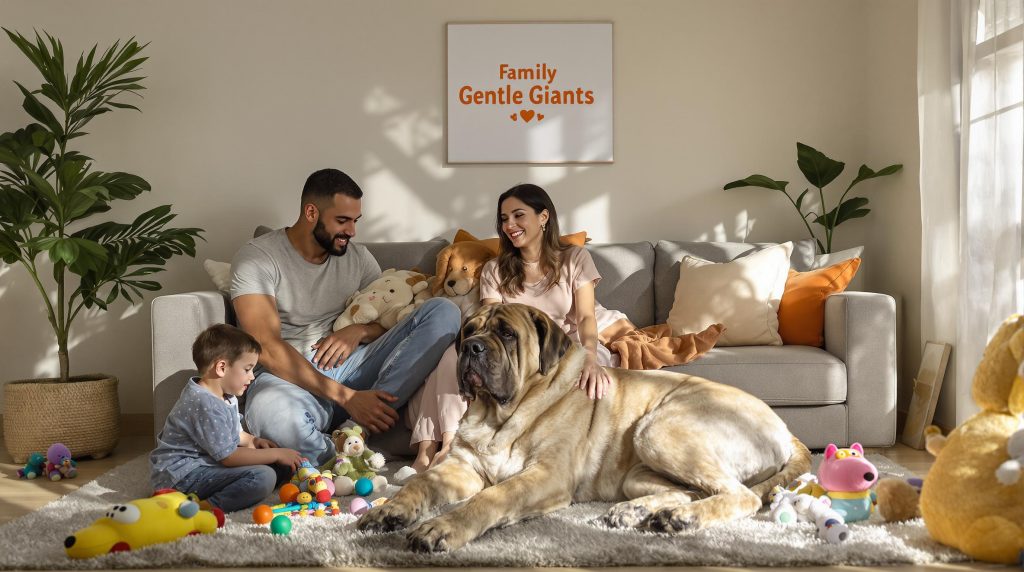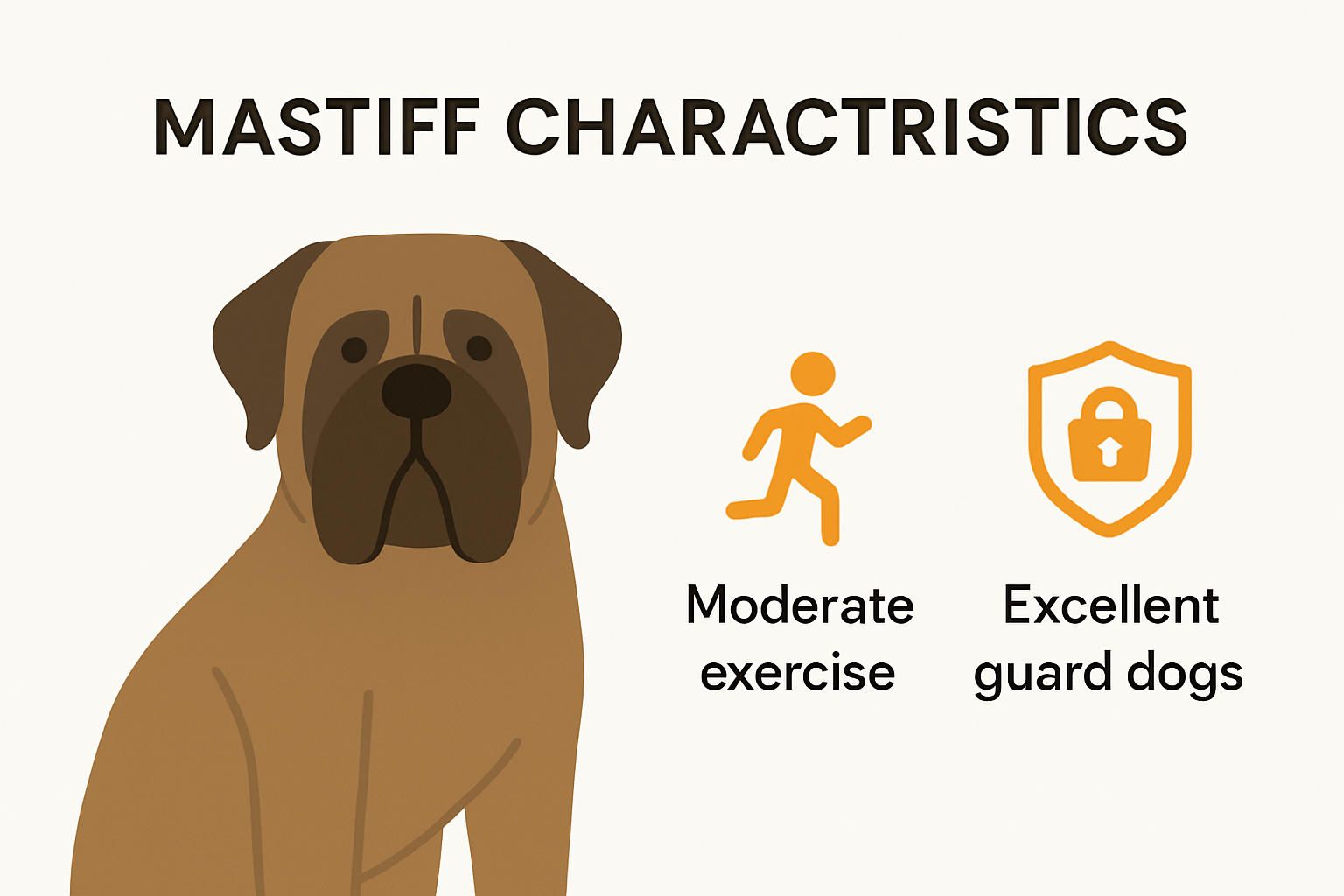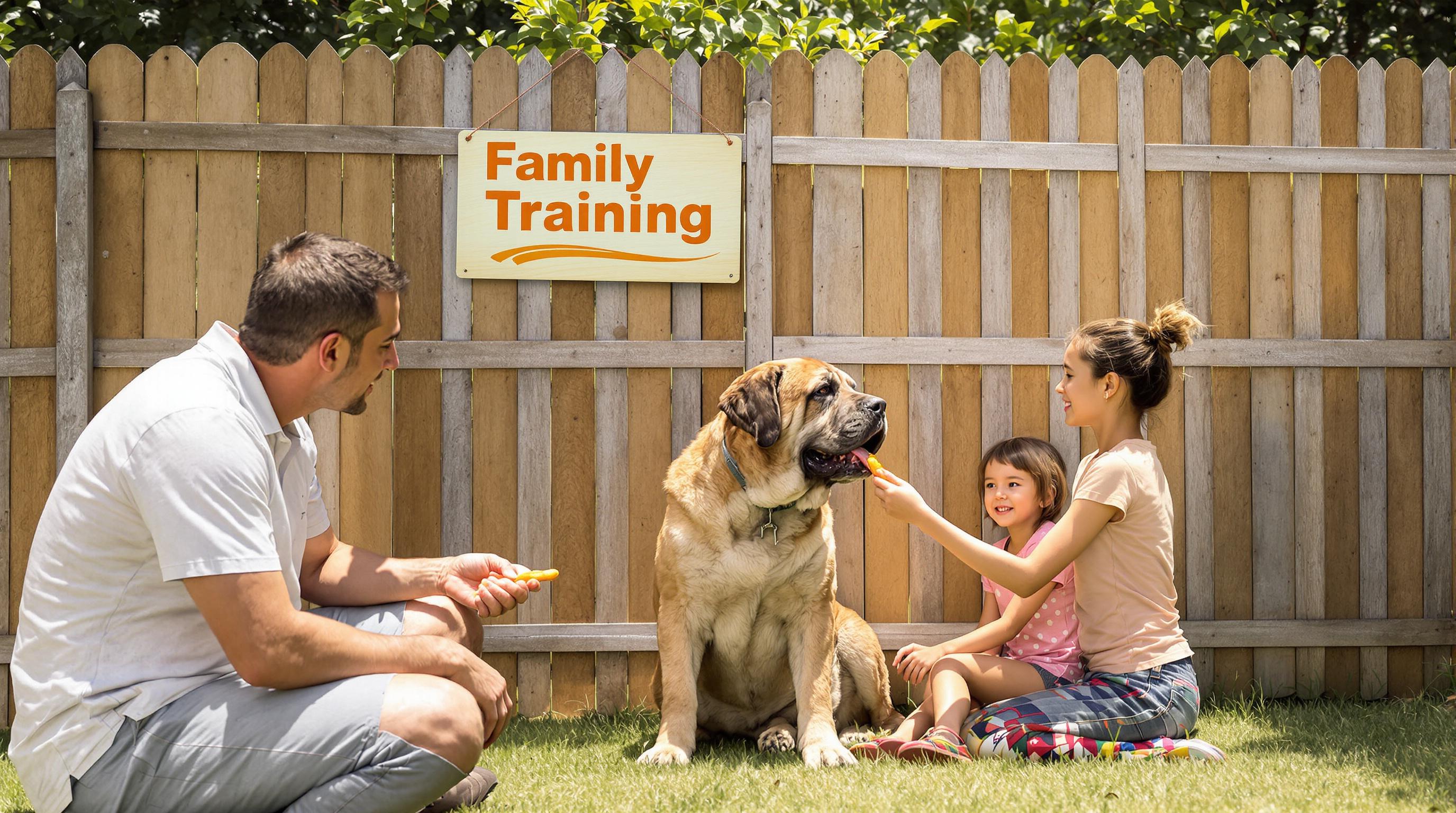Mastiffs are famous for their size and stoic looks. Most people see them and imagine a fierce watchdog or a hulking guard at the gate. Yet the truth is, these giants are better known for their gentle hearts than their bite. Mastiffs have been loyal companions for over 5,000 years, dating back to ancient Babylon. Turns out, their biggest strength is not just protection but the way they mesh patience and affection into family life.
Table of Contents
- Distinctive Mastiff Traits And History
- Mastiff Temperament And Family Role
- Essential Mastiff Care And Training Needs
- Is The Mastiff The Right Guard Dog For You?
Quick Summary
| Takeaway | Explanation |
|---|---|
| Mastiffs Are Gentle Giants | Despite their imposing size, Mastiffs are known for their affectionate and patient nature, making them excellent family companions. |
| Early Socialization Is Crucial | Early exposure to diverse environments and interactions is essential to foster well-adjusted behavior and prevent overprotectiveness in Mastiffs. |
| Careful Exercise Management Required | Mastiffs need moderate, structured exercise routines tailored to their size, with attention to prevent overheating and obesity. |
| Effective Guard Dog Traits | Mastiffs possess protective instincts but are discerning and not inherently aggressive, making them suitable guardians for homes. |
| Consistent Training Is Key | Training a Mastiff should focus on positive reinforcement and consistent leadership to encourage responsiveness and trust. |
Distinctive Mastiff Traits and History
The Mastiff breed represents a remarkable journey through human history, embodying strength, loyalty, and protection across millennia. These magnificent dogs have roots that stretch back thousands of years, with a lineage that speaks to their incredible adaptability and enduring partnership with humans.
Ancient Origins and Historical Significance
Mastiff-like dogs have an extraordinary historical presence that predates many modern civilizations. Archaeological evidence from the Babylonian empire reveals bas-reliefs depicting massive dogs hunting lions in desert landscapes, demonstrating their ancient role as formidable guardians and hunters. According to historical research, these dogs have been documented in European and Asian cultures as far back as 3000 BCE, making them one of the oldest recognizable dog breeds in human history.
The British played a pivotal role in developing the modern Mastiff breed, utilizing these powerful dogs to guard estates and castles. Estate owners would release these dogs at night, creating an intimidating security system that protected property and deterred potential intruders. This historical function shaped the breed’s protective instincts and robust physical characteristics that we recognize today.
Breed Characteristics and Temperament
Mastiffs are distinguished by their impressive physical presence and complex temperament. Veterinary experts note that while these dogs appear imposing, they possess a surprisingly gentle nature, especially with family members. Their broad head, drooping ears, and short, coarse coat are hallmark traits that set them apart from other large breed dogs.
Their temperament is a fascinating blend of protective instinct and gentle companionship. Mastiffs are typically aloof with strangers but remarkably patient and kind with children. This nuanced personality requires early socialization to ensure they develop into well-adjusted adult dogs. Training these intelligent canines demands a combination of firm leadership and positive reinforcement, as they can be both quick learners and occasionally stubborn.
Modern Role and Recognition
The American Kennel Club officially recognized the Mastiff breed in 1885, solidifying its status as a distinguished purebred dog. Today, Mastiffs continue to serve in various roles beyond their historical guardian functions. While they are cherished family companions, their protective instincts and imposing size make them excellent working dogs in security and protection contexts.
Explore more about the fascinating lineage of Italian Mastiffs to understand how these remarkable dogs have evolved alongside human civilization, maintaining their core characteristics of loyalty, strength, and protective instinct through generations.
Here’s a table summarizing key Mastiff breed characteristics and temperament traits discussed, for quick reference:
| Characteristic | Description |
|---|---|
| Physical Presence | Large, muscular, broad head, drooping ears, short coarse coat |
| Temperament | Protective yet gentle; patient with family, aloof with strangers |
| Family Behavior | Deep affection and loyalty; excellent with children |
| Training Needs | Intelligent; responds to firm, positive reinforcement; may be stubborn at times |
| Socialization Importance | Early exposure helps prevent overprotectiveness, encourages well-adjusted behavior |
| Historical Role | Guarding, hunting, estate protection; roots in ancient societies |
| Modern Role | Family companion, watchdog, working dog in security/protection |
Mastiff Temperament and Family Role
Mastiffs are remarkable dogs that embody a unique blend of strength and gentleness, making them extraordinary family companions. Their complex temperament combines protective instincts with an innate sensitivity that sets them apart from other large breed dogs.
Gentle Giants in Family Dynamics
Veterinary experts highlight that Mastiffs are characteristically gentle and eager to please, despite their imposing physical presence. These dogs form deep emotional connections with family members, displaying an extraordinary capacity for affection and patience. Their temperament makes them particularly well-suited for families seeking a loyal and protective companion.
While Mastiffs are incredibly loving with their immediate family, they maintain a reserved demeanor around strangers. Research from animal behaviorists suggests this balanced approach stems from their historical role as guardians. They are not aggressive by nature but remain vigilant, creating a natural security system for their household. This instinctive protectiveness makes them excellent watchdogs who rarely bark without genuine cause.
Navigating Social Interactions
Socialization plays a crucial role in shaping a Mastiff’s temperament. Early exposure to different people, animals, and environments helps them develop into well-adjusted adults. Their potential size and strength require thoughtful training approaches. Canine behavior specialists recommend positive reinforcement techniques that respect the breed’s sensitive nature while establishing clear leadership.
Mastiffs typically do well with other household pets, especially when introduced during puppyhood. However, their large size means they might accidentally knock over small children or elderly family members. Supervision and teaching children how to interact respectfully with these gentle giants are essential. Families with older children or adults often find Mastiffs to be perfect companions.
Training and Family Integration
Training a Mastiff requires patience and consistency. They are intelligent dogs that learn quickly but can be somewhat stubborn. Reward-based training methods work best, combining gentle guidance with positive reinforcement. Their desire to please their family makes them responsive to calm, confident leadership.
Learn more about integrating large breed dogs into family settings to understand the nuanced approach needed for successful dog ownership. Mastiffs are not just pets but true family members who offer unwavering loyalty, protection, and profound emotional connection.
Essential Mastiff Care and Training Needs
Caring for a Mastiff requires a comprehensive approach that addresses their unique physical, emotional, and training needs. These gentle giants demand specialized attention to ensure they develop into well-adjusted, healthy companions.
Exercise and Physical Management
Veterinary experts recommend that Mastiffs need carefully structured exercise routines. Daily physical activity should be moderate and tailored to their large frame, typically consisting of 30-60 minutes of activity split into multiple sessions. Research from animal health professionals emphasizes the importance of avoiding strenuous exercise, particularly in hot weather, due to their susceptibility to overheating.
Mastiffs adapt well to various living spaces, including apartments, provided they receive consistent exercise. Short walks, gentle play sessions, and mental stimulation are crucial. Owners should be mindful of their dog’s weight, as these breeds are prone to obesity. Controlled diet and appropriate exercise help prevent joint issues and maintain overall health. Puppies require special attention to prevent overexertion, with exercise intensity gradually increasing as they mature.
The following checklist table summarizes important Mastiff daily care and exercise management tips for owners:
| Care Task | Recommended Practice | Essential for Health/Safety |
|---|---|---|
| Daily Exercise Duration | 30-60 mins (split into sessions) | Yes |
| Exercise Type | Moderate walks and gentle play | Yes |
| Avoid Hot Weather Activity | Essential due to overheating risk | Yes |
| Monitor Weight | Prevent obesity and joint issues | Yes |
| Puppy Exercise Restrictions | Gradually increase as dog matures | Yes |
| Mental Stimulation | Regular play and varied activities | Yes |
Training Approach and Socialization
Training a Mastiff demands patience, consistency, and positive reinforcement. Canine behavior specialists highlight that these dogs are eager to please but can be stubborn. Short, engaging training sessions work best, keeping the dog’s attention and making learning enjoyable. Their sensitive nature requires a gentle yet firm approach that builds trust and respect.
Early socialization is critical for Mastiffs. Exposing them to various people, animals, and environments helps prevent overprotective behaviors and ensures they become well-rounded companions. Obedience training should focus on basic commands and controlled interactions. Learn more about overcoming training challenges to develop a strong, positive relationship with your Mastiff.
Health Considerations and Specialized Care
Mastiffs are susceptible to several breed-specific health concerns that require proactive management. Hip dysplasia, bloat, and weight-related issues are primary considerations. Feeding smaller, frequent meals and avoiding vigorous exercise around mealtimes can help mitigate potential health risks. Their short, coarse coat requires minimal grooming, but regular brushing helps manage shedding and promotes bonding.
Nutritional needs are particularly important for this breed. Large-breed puppy food supports proper growth and development, potentially reducing the risk of joint problems. Adult Mastiffs benefit from carefully measured diets that prevent obesity while providing adequate nutrition. Regular veterinary check-ups, preventative care, and attentive monitoring are essential to address any potential health concerns early.
Owning a Mastiff is a significant commitment that requires understanding their unique needs. These loyal companions offer incredible love and protection when provided with appropriate care, training, and attention.
Is the Mastiff the Right Guard Dog for You?
Choosing a guard dog is a significant decision that requires careful consideration of breed characteristics, lifestyle compatibility, and personal expectations. Mastiffs offer a unique combination of protective instincts and gentle temperament that makes them exceptional guardians for the right households.
Protective Instincts and Behavioral Characteristics
Breed experts from the American Kennel Club highlight that Mastiffs are naturally protective without being inherently aggressive. Their intimidating size and deep bark serve as powerful deterrents to potential intruders. Unlike some guard dog breeds that may react impulsively, Mastiffs are discerning guardians who assess threats carefully before responding.
Their protective nature stems from a deep loyalty to family members. Research on canine behavior indicates that Mastiffs have an innate ability to distinguish between genuine threats and normal household interactions. This means they are less likely to create unnecessary tension or react aggressively to routine visitors, making them ideal for families seeking a balanced approach to home protection.
Suitability for Different Living Environments
Mastiffs are versatile guardians that can adapt to various living situations. Their protective instincts work effectively in both urban apartments and rural properties. However, potential owners must understand that their guardian role goes beyond physical protection. These dogs provide a psychological sense of security, creating an invisible barrier that deters potential threats.
Space and lifestyle considerations are crucial. While Mastiffs are not hyperactive dogs, they require adequate room to move and regular exercise. Families with limited space should ensure they can provide sufficient mental and physical stimulation. Their size means they might unintentionally knock over small children or furniture, so careful management is essential.
Training and Preparation for Guard Dog Roles
Successful guard dog integration requires comprehensive training and socialization. Canine training specialists recommend starting socialization early to ensure the Mastiff can differentiate between normal interactions and genuine threats. Positive reinforcement techniques work best, helping the dog understand expected behaviors without developing aggressive tendencies.
Potential owners should invest time in professional training and consistent home instruction. Mastiffs are intelligent and responsive but can be stubborn. They require an owner who can provide firm, consistent leadership while maintaining a loving environment. The goal is to create a guardian who is confident and protective without being overly reactive.
Before bringing a Mastiff home as a guard dog, honestly assess your lifestyle, living situation, and commitment to training. These remarkable dogs offer unparalleled protection and companionship when matched with the right family dynamics and expectations. Their ability to blend gentle companionship with steadfast protection makes them extraordinary guardians for those prepared to meet their unique needs.
Frequently Asked Questions
What is the temperament of a Mastiff?
How much exercise do Mastiffs need?
Are Mastiffs good guard dogs?
How should I train my Mastiff?
Unlock the Secrets to a Truly Happy Mastiff Companion
Tired of searching for clear answers on how to raise a well-adjusted, healthy Mastiff? This article has shown just how essential proper breed knowledge, early socialization, and effective exercise routines are for your gentle giant. If you found the insights on family dynamics, protective instincts, and care routines valuable, imagine how much further your journey could go with guidance tailored specifically to the Cane Corso Mastiff.
Learn more about vital breed traits and real-world owner tips at our Breed Basics resource
Join a caring community and gain access to expert-backed care guides, step-by-step training strategies, and proven tips designed just for Cane Corso and Mastiff owners. Do not wait to give your loyal companion the fulfilling and secure life they deserve. Discover everything you need to know at Cane Corso Mastiff today and start your best chapter as a Mastiff owner.
Recommended
- The Fascinating History of Italian Mastiffs
- Cane Corso Breed Mix Guide 2025: Traits, Care, and Best Matches
- Cane Corso Mastiff – All You Need To Know About Italian Masiff Dog
- Cane Corso Size And Weight – 3 Key Considerations For Potential Owners – Cane Corso Mastiff




